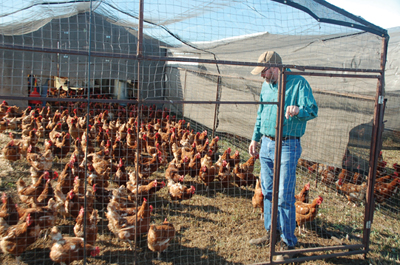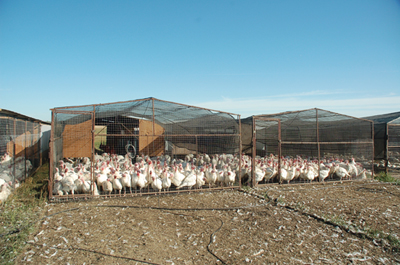
From Oil to Organic
By David Schmidt
Features New Technology ProductionSunworks Farm is now one of Canada’s largest organic poultry operations, marketing 100,000 broilers
Sometimes it takes an outsider to recognize an opportunity. In 1992, oilfield surveyor Ron Hamilton, a young man with no background
in agriculture, moved his family from Leduc to a virtually abandoned
240-acre farm near Armena, Alta.
Sometimes it takes an outsider to recognize an opportunity.
In 1992, oilfield surveyor Ron Hamilton, a young man with no background in agriculture, moved his family from Leduc to a virtually abandoned 240-acre farm near Armena, Alta. He and his wife, Sheila, hoped to grow organic food for Sheila, who was suffering from fibromyalgia and other health issues. They soon decided they needed to do more with the land, so signed up for a holistic management course in 1995-96.
 |
|
| Sunworks Farm Ron Hamilton says turkey barns are moved every day and chicken and layer barns every other day, half the length of the total enclosure, so the birds get to spend a day or two pecking in their own litter. |
“It opened our eyes to the opportunities that were out there,” Hamilton told a group of Canadian farm writers during their visit to the farm Sept. 11.
Thus was born Sunworks Farm. The Hamiltons began by brooding 80 chicks in 1997. The following year, they contracted to raise 3,500 chickens. When that contract fell through, the Hamiltons decided to take them to a farmers market.
It worked and the farm has grown ever since and is now one of Canada’s largest organic poultry and livestock operations. This year, Sunworks will market 100,000 broilers, 1,500 turkeys, 178 beef animals, about a million eggs (from Sexalink layers) and a smaller number of ducks, geese, hogs, lambs and bison.
“The first four years, we grew at 1,000 per cent/year. This year we are growing at 15 per cent,” Hamilton says.
 |
|
The poultry is produced on their own farm, a sister-in-law grows the hogs and lambs, another producer provides the bison, while the beef animals come from the Peace. Meat is currently custom-processed but Sunworks hopes to get funding from the new Alberta Livestock Marketing Agency to build its own provincially inspected on-farm poultry processing plant.
About 90 per cent of their production is sold through farmers markets in Calgary and Edmonton. Up to eight people work at each farmers market. Another 10 work at the farm.
“We collect all the eggs by hand so that takes up most of our labour,” Hamilton notes.
What does not go through the farmers markets is sold to restaurants, health food stores and through Blush Lane Organic Market, their daughter’s retail organic market in Calgary.
“Our best weeks are the first week of school, the week before and week of Thanksgiving, Christmas and the first week of January.”
Poultry are raised in movable shelters, which include 20 to 24 feet of “indoor” area with a screened floor and an equivalent amount of “outdoor” area. Although the outdoor areas were covered with shade cloth, that is being replaced with metal, as the new National Organic Standards now require poultry to be raised in barns for biosecurity reasons.
“I call my structures field barns,” Hamilton says, noting “it’s all in how you interpret the standards.”
He says the barns are bio-secure and “predator-friendly.” Not only are the barns fully enclosed, but they are surrounded by an electric fence to discourage predators.
“One touch of the electric fence and the predators don’t come back.”
Four years ago, before installing the electric fences, Hamilton tried to use llamas as predator controls after getting a guarantee from the seller. Soon after buying the llamas, he decided they weren’t doing the job effectively, so he asked for his money back.
“The seller sent back my money but never came to collect the llamas – that shows the state of the llama business,” he said.
Hamilton still has the llamas but basically lets them run wild. “They graze in the summer and I give them one bale of hay in the fall. It’s enough to last them all winter.”
Turkey barns are moved every day and chicken and layer barns every other day, half the length of the total enclosure, so the birds get to spend a day or two pecking in their own litter. It takes a year to move the barns the length of a field. At the end of the year, barns are moved sideways to a new area and gradually towed back so land is only used every other year. While that used to be ample time to regenerate a pasture, the current drought conditions in central Alberta mean a year is barely enough.
Chickens are fed a ration of certified organic wheat, al-falfa meal, peas, soy and minerals. In 2007, an on-farm feed mill was built to allow Sunworks to buy screenings and other low-cost feedstuffs when available and create its own rations.
“Our feed costs are double those of conventional producers so we need to do everything we can to save costs,” Hamilton points out.
Sunworks is certified organic through QMI Inc. and certified humane through the B.C. SPCA.
“We not only have certified organic chickens, we have certified happy chickens,” Hamilton says – a fact the family proudly promotes at the farmers markets.
Hamilton recently installed two new Biovator in-vessel composters, noting they are not only an efficient way to manage mortalities but also add another revenue stream to the farm.
“It’s a continuous seven-day process and we can sell the compost at $20 for 20 pounds,” he notes. “We try to add value wherever we can.”
Print this page